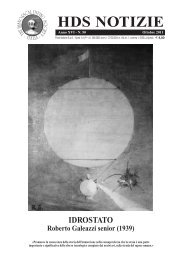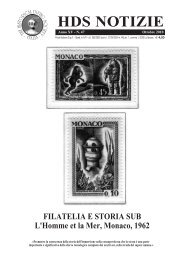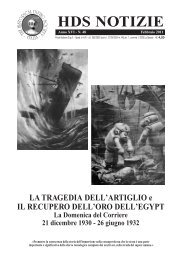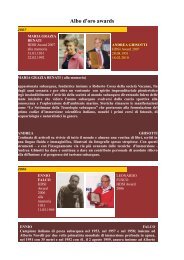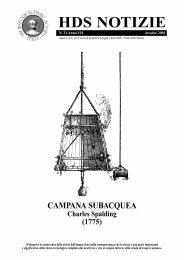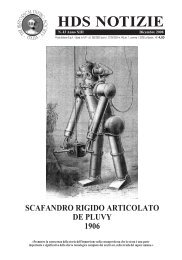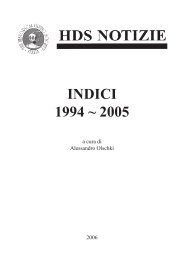hds internet - The Historical Diving Society Italia
hds internet - The Historical Diving Society Italia
hds internet - The Historical Diving Society Italia
Create successful ePaper yourself
Turn your PDF publications into a flip-book with our unique Google optimized e-Paper software.
Later, the fourth part of his Treasure for Travellers<br />
by Sea and Land (1578) was to be entitled,<br />
‘...touching on the Art of Statics, as to know the<br />
weight of any ship swimming on the water, and<br />
such other like etc.’. While it mentioned nothing<br />
about ship salvage generally, chapter four began<br />
with a discussion on buoyancy calculations, based<br />
on Archimedes’ principal and included a method<br />
for calculating the weight of sunken ordnance 7) .<br />
His design for an underwater boat finally<br />
appeared in Inventions and Devises (1578) 8) , a<br />
book that he dedicated to Sir William Winter<br />
under whom he said he had served as a ‘poor<br />
Gunner’. Winter had been responsible, in 1569,<br />
for deciding the level of the armament on the<br />
royal ships that were to later defeat the great<br />
(Spanish) Armada of ships in1588, on their way<br />
for an attempted invasion of England. Though<br />
Bourne may never have been to sea, as in<br />
Treasure for Travellers he said that he was not a<br />
carpenter or a ‘usual seaman’. <strong>The</strong> accepted<br />
view is that he served under Winter ashore at the<br />
gun batteries on the Gravesend ‘bulwarks’ - two<br />
forts on opposite banks of the river Thames,<br />
where it first narrows on its way up to London 9) .<br />
It is not generally appreciated that, in Inventions<br />
and Devices, Bourne in fact introduced three<br />
very different devices for diving. Probably<br />
because the underwater boat, presented as device<br />
number 18, with its hollow mast supplying air<br />
from the surface, has subsequently provided an<br />
immediate focus of interest.<br />
‘And also it is possible to make a Ship or Boat<br />
that may go under the water unto the bottom,<br />
and so to come up again at your pleasure ...<br />
that anything that sinks, is heavier than the<br />
proportion of so much water, and if it is<br />
lighter than the magnitude of so much water,<br />
then it swims or appears above the water...’<br />
He proposed using a small ship, boat or bark<br />
with, ‘A closed orlop so that no water may come<br />
into it, as low as may be...’. An orlop being a<br />
temporary deck on trading vessels and the lowest<br />
deck in ships of war, consisting of a platform<br />
7) <strong>The</strong> impression is that ordnance was accidentally dropped into<br />
the water quite regularly and had then to be located, grappled for<br />
and recovered.<br />
8) William Bourne, Inuentions and Deuises, Thomas Woodcock:<br />
Lond., 1578<br />
9) op.cit. 2, p.211<br />
HDS NOTIZIE N. 23 - Giugno 2002 - pag. 7<br />
Le idee di Bourne riguardo una possibile imbarcazione<br />
subacquea forse iniziarono abbastanza<br />
presto nella sua carriera, quando si rivolse a<br />
William Cecil (Lord Burghley), Primo Ministro<br />
di Stato di Elisabetta I, con un manoscritto, <strong>The</strong><br />
Nature and Qualities of Water: as touching the<br />
Swimming and Sinking of Things. In seguito<br />
venne interrogato con grande attenzione da<br />
Burghley riguardo il progetto della nave. Più<br />
tardi Bourne produsse un ‘piccolo libro di statica’<br />
che disse essersi rivelato utile per marinai e<br />
maestri d’ascia e, poco prima del 1572, un lavoro<br />
sulla qualità del vetro per l’ottica 6) .<br />
In seguito la quarta parte del suo Treasure for<br />
Travellers by Sea and Land (1578) s’intitolò:<br />
‘…sull’Arte della Statica, come conoscere il<br />
peso d’ogni nave galleggiante sull’acqua, e altro<br />
di simile…’ . Mentre non menzionava nulla<br />
riguardo il recupero di navi in generale, il quarto<br />
capitolo iniziava con una discussione sui calcoli<br />
della spinta idrostatica, basati sul principio di<br />
Archimede e includeva un metodo per calcolare<br />
il peso delle artiglierie affondate 7) .<br />
Il suo progetto per un’imbarcazione subacquea<br />
apparve infine in Inventions and Devises (1578) 8) ,<br />
un libro che dedicò a Sir William Winter sotto il<br />
cui comando disse di aver servito come ‘povero<br />
cannoniere’. Winter, nel 1569, era stato responsabile<br />
nel decidere il livello di armamento sulle<br />
navi reali che più tardi, nel 1588, avrebbero<br />
sconfitto la Grande Armata spagnola sulla loro<br />
rotta per un tentativo d’invasione dell’Inghilterra.<br />
Sebbene Bourne potrebbe non essere mai<br />
stato per mare, dal momento che nel suo<br />
Treasure for Travellers afferma di non essere un<br />
carpentiere o un ‘comune marinaio’. La versione<br />
accettata è che sotto il comando di Winter servisse<br />
nelle batterie in terraferma sui bastioni di<br />
Gravesend – due fortificazioni sulle rive opposte<br />
del Tamigi, nel primo punto in cui si stringe nel<br />
suo corso verso Londra 9) .<br />
In genere non viene considerato che in<br />
Inventions and Devices, Bourne presentava in<br />
6) op.cit. 3, p. 319 and p.321. A treatise on the properties of<br />
Glasses for Optical purposes (Ms.Lansd.Mus.Brit.121). Sembra<br />
che Bourne non sapesse come venivano prodotte le lenti.<br />
7) L’impressione è che l’artiglieria cadesse accidentalmente in<br />
acqua piuttosto regolarmente, e quindi dovesse essere individuata,<br />
afferrata e recuperata.<br />
8) William Bourne, Inventions and Devises, Thomas Woodcock:<br />
Lond., 1578<br />
9) op.cit. 2, p.211



